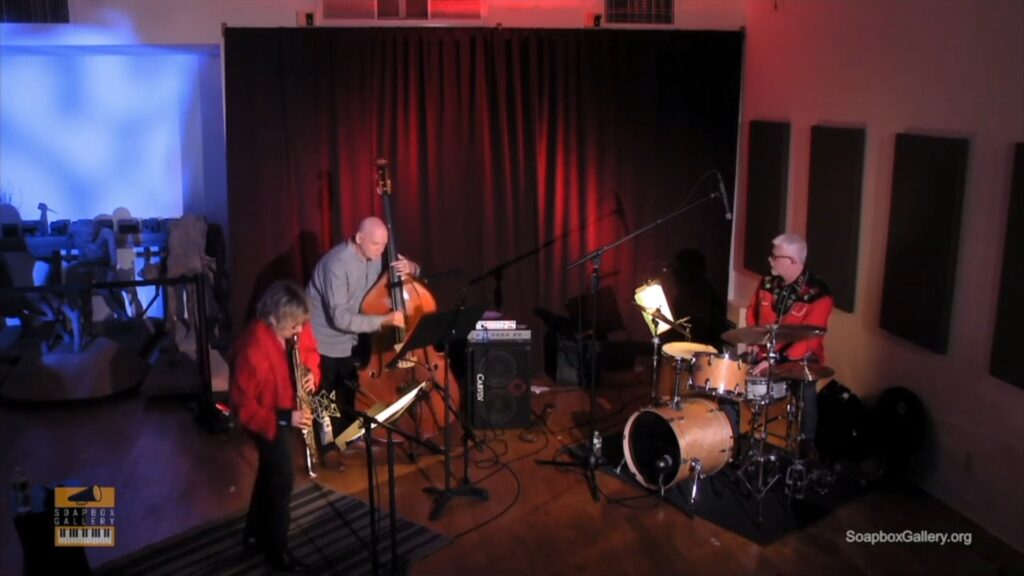
ARTIST: Jane Ira Bloom
DATE: April 14, 2024
VENUE: Soapbox Gallery, Brooklyn, NY
PERSONNEL: Jane Ira Bloom (ss); Mark Helias (b); Matt Wilson (d)
It’s been a long pandemic. Indeed, it has, and Jane Ira Bloom has taken her time to return to live performing. Her composing and recording activity increased during lockdown, but there have been few opportunities to hear her new music in person. A recent Sunday afternoon trio gig at Brooklyn’s Soapbox Gallery (also live-streamed) proved that Bloom remains a viable creative force in progressive jazz. Appearing with two longtime colleagues, bassist Mark Helias and drummer Matt Wilson, Bloom introduced several new pieces along with a few of her older compositions. On the opener, “All Hat, No Cattle”, Bloom’s rich and throaty soprano sax tone supported her long, unpredictable lines. As her solo intensified, Bloom added her unique Doppler effect by swinging the bell of her horn across the plane of the microphone. Beneath it all, Helias and Wilson created an open, free, and swinging groove which left the harmonic options open. “Beckett” (dedicated to the playwright) was appropriately abstract, with solo breaks appearing between melodic phrases. It wasn’t entirely clear where the composition ended and the improvisations started, but the constant interplay of the three instruments created a fascinating soundscape. “Varo” dates back to Bloom’s first recording. Originally written for bass and sax, Willson added an active third part consisting of rim shots and sticks played on the edges of his toms. Helias added the original bass ostinato, and Bloom stretched and bent notes over the cross-rhythms. The mood became open and lonely for a new ballad, “Cry Without an Alphabet”. Here, Bloom’s rich tone enhanced the sorrowful melody, while Helias and Wilson left plenty of space behind her. Helias’ impressively agile solo bass opened a medley of two new works, “Polaris” and “St. Mark’s Tomorrow”. Bloom and Wilson crept in so that their contributions maintained the listener’s focus. Bloom’s short lines contrasted with Helias’ bowed ideas, while Wilson created fascinating sounds from an ancient cymbal. Wilson moved to his standard cymbals to accentuate the elastic melody of the second piece. “Sonic Surfer” was a wild ride, with Wilson blazing a fast tempo on ride cymbal under Bloom’s searing improvisation. Helias’ solo evolved into a three-way conversation in quick Latin time. The active discussion heated up on the tense original “Current Events” before dissolving into an eerie duet between Bloom and Helias. “Seven Strings” was performed in memory of composer and percussionist Frank Bennett (the piece was originally written for Bennett’s wife Geetha). Helias bounced his bow against the strings in the intro, and Wilson created mournful sounds from a Chinese hand cymbal under Bloom’s heartfelt melody. The various elements grew exponentially as Bloom created her dramatic solo. The three voices united as the piece came to a quiet ending. Bloom introduced “Vanishing Hat” as an old chestnut, but I was unable to find an earlier recording of the piece. It is a delightful romp with an engaging melody and a strong bass line. Bloom’s energetic solo worked in a recurring rhythmic motive and several brilliant runs up and down the horn. Wilson’s solo combined deft brushwork with quick pitch manipulations on the toms. Helias was left on his own for his solo, and his statement was impressive on emotional and technical levels. Bloom followed with a dazzling cadenza. Despite the title, I didn’t find many Western motives in the closer “Be Cowboy”, but it did explain Wilson’s bright red Wrangler shirt. The piece inspired another round of creative solos from this fine trio. (Due to a missed train connection, I was unable to attend this concert in person; my thanks to Jimmie Greenfield and Jane Ira Bloom for making the live- stream available for this review.)
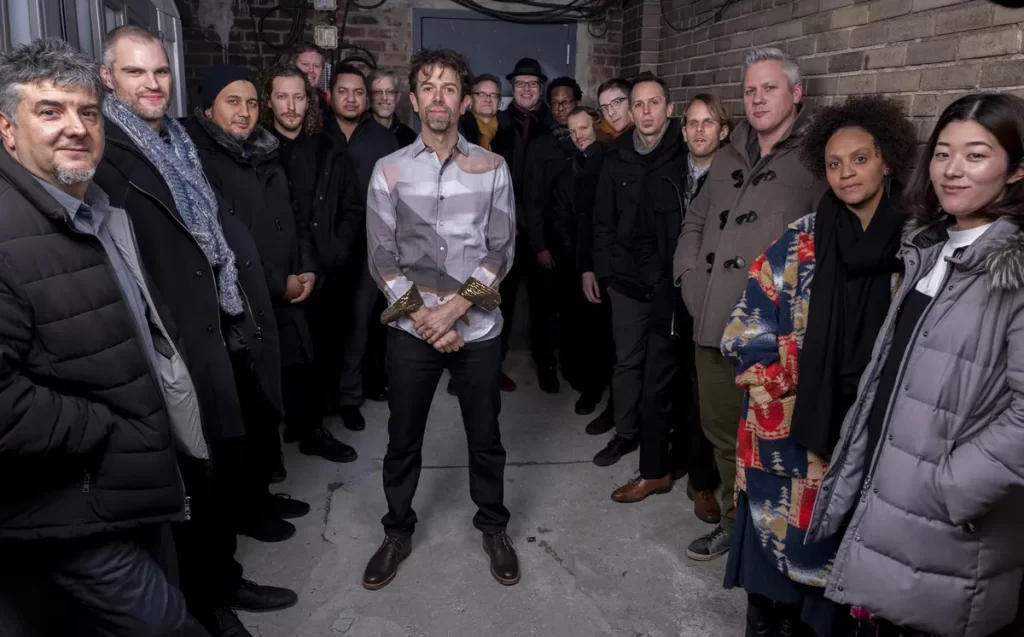
ARTIST: Ryan Keberle’s All Ears Orchestra
DATE: April 14, 2024
VENUE: Birdland, NYC
PERSONNEL: Tony Kadleck, Mike Rodriguez, Michael Dudley, Ingrid Jensen (tp); Ryan Keberle, Marshall Gilkes, Mike Davis (tb); Chris Komer (fh); Marcus Rojas (tuba); Alejandro Aviles, Erica von Kleist, Jeremy Powell, Lucas Pino, Carl Maraghi (r); Martha Kato (p); Ike Sturm (b); Jimmy Macbride (d); Erin Hogan (v).
Trombonist/composer Ryan Keberle has no shortage of ensembles. In addition to his free-lance work around New York (primarily with the Maria Schneider, Darcy James Argue, and Ryan Truesdell orchestras) he leads four distinct professional groups: Catharsis is a politically-driven small combo, Reverso fuses chamber jazz with French Impressionist music of the early 20th century, and Collectiv do Brasil explores the rich musical heritage of samba, bossa nova, and MPB. The fourth group is his big band, the All Ears Orchestra. As far as I know, the group has not yet recorded, and their book of arrangements is quite small. At their recent Sunday afternoon gig at Birdland, they performed eight arrangements, all of which had been played at previous concerts, and all adapted from works originally composed for Keberle’s other groups (The above is not a criticism of Keberle, who has a busy schedule of teaching and performing. After all, it takes time to write big band charts!) Keberle is a distinctive arranger who is not satisfied with repeating the same voicings that appear in jazz arranging books. One piece of evidence can be seen even before the band plays: his low brass section is not the typical quartet of trombones, but rather a pair of trombones bookended by French horn and tuba. Keberle told me that he decided to use the horn and tuba for the unique sounds produced by their conical shapes, and the musicians who play them (Chris Komer and Marcus Rojas, respectively) for their outstanding creativity. While Rojas did not solo at the Birdland concert, Komer did, and he displayed extraordinary control of the instrument and outstanding improvised lines. (I’ve heard Rojas solo in another ensemble and can easily apply the same comments to him.) Keberle’s unique scoring style was most apparent in the opening passages of “Something Speaking” which opens with a rich brass choir and then expands to the rest of the band through subtle entrances of soprano and baritone saxes. The main theme is presented in a unison line by tenor saxes, trombones, and horn with a warm and gentle countermelody in the trumpets. The mixed unison voicing returns as a background for a trumpet solo, while a simple pyramid chord emerges behind an alto sax improvisation. The concept of building chords against unison melodies evolves in the following ensemble choruses as the various instrumental groupings merge and separate. Several of the band’s newer works incorporate a solo soprano (Erin Hogan) singing wordless themes over the band. This is not a new technique—Kenny Wheeler and Maria Schnieder have also used it—but Keberle expands the role to let the vocalist sing with words, notably when leading the final vocal chorus on Keberle’s political anthem, ‘Become the Water, Shine a Light”. Followers of the New York jazz scene will notice several familiar names among the band personnel. Of these, trumpeters Mike Rodriguez and Ingrid Jensen, trombonist Marshall Gilkes, and saxophonists Alejandro Aviles and Lucas Pino were standout soloists, enhancing—but not overwhelming—Keberle’s compositions. Keberle played on only one piece during the concert, and that was a highlight: a beautiful ballad titled “When I’m Away”. Playing before an audience which included several members of his family, this song had a special poignance, reflecting the normal life of a busy musician. When Keberle finds the time, he should bolster the repertoire of the All Ears Orchestra with a few new originals. This is a side of his artistry worth exploring.
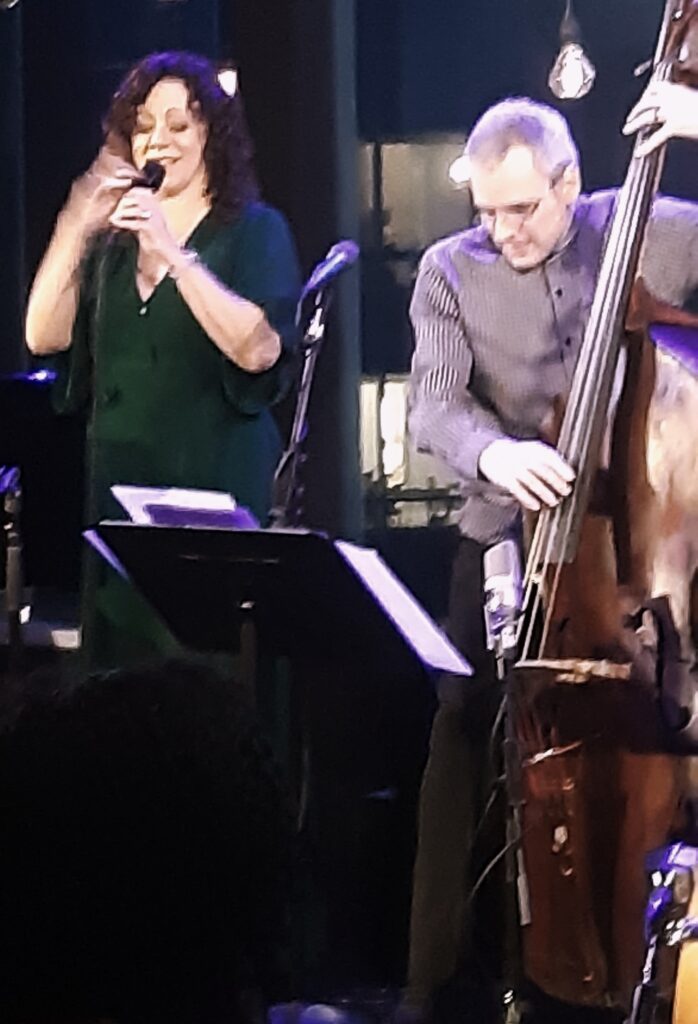
ARTIST: Luciana Souza with Trio Corrente
DATE: April 14, 2024
VENUE: Dizzy’s (Jazz at Lincoln Center), NYC
PERSONNEL: Luciana Souza (v); Fabio Torres (p); Paulo Paulelli (b); Mauricio Zottarelli (d).
Over the past two decades, I have heard Luciana Souza sing in various settings, including duets with Romero Lubambo, trios and quartets under her own leadership, and with full orchestras. She has a great gift for enhancing art with her voice, whether it is her intense settings of Pablo Neruda poems or an obscure Tom Jobim song. To use an old show biz term, she “always delivers” even when conditions beyond her control are not optimal. But when all the exterior elements are in harmony, she is the most consistently astonishing musician performing jazz and Brazilian music today. My most recent encounter with Souza came at the conclusion of a highly acclaimed week-long run at Dizzy’s in the Jazz at Lincoln Center complex. Two members of the rhythm section—pianist Fabio Torres and bassist Paulo Paulellli—were longtime members of the Brazilian Trio Corrente but the group’s regular drummer, Edu Ribiero, was temporarily detained at home with family matters. His sub was Mauricio Zottarelli, who learned the concert repertoire during a one-hour rehearsal in Boston. After a week of performing this music, Zottarelli sounded like a veteran of the band. And while Souza has worked with this trio for just over a year, she has also become an integral part of the group. Souza’s current collaboration with Trio Corrente started with the album “Cometa“, recorded in January 2023, just as Brazil was undergoing another political upheaval. The chemistry of this quartet was already evident on that recording (which led to its inclusion on my best-of-2023 list) but at Dizzy’s, the ensemble was much tighter, and Souza was on fire, taking great risks in her solos, and deepening the emotions of her ballad interpretations. She seemed fearless as she improvised on the opening “Requebre Que Eu Dou Un Doce”, and her stunning rendition of “Sem Você” was even more intense than the album version. The highlight of the set was yet to come. Souza spotted percussionist/vocalist Cyro Baptista in the audience and encouraged him to join the group onstage. Having no instruments with him, Baptista clapped his hands in complex rhythms and vocalized a line which alternated between speech and song. Souza found a way to turn this unique vocal mixture into a duet, and for two or three unforgettable minutes, these two brilliant musicians communicated without words and in a seemingly new musical language. Later in the concert, Souza reconstructed two Brazilian standards, compressing the words and music of “So Danço Samba” into approximately half its usual length, and then taking the opposite approach on “Corcovado”. Performing the latter as a duet with Torres, there was a brief moment when the two artists seemed to clash, landing a half-step apart on a held note. Many instrumentalists would try to correct the problem immediately, hoping that the audience wouldn’t hear the apparent mistake. Not this time. Each held their place and Souza added a slight crescendo to increase the tension, before finally resolving the dissonance. I can’t remember for certain, but I suspect that the audience all exhaled in unison after that episode! This amazing concert was over all too soon, but its artistic success should encourage continued collaborations on disc and in concert. I can only recommend one significant difference: the group’s name should be changed to QUARTETO Corrente, whenever it features its newest and treasured member, Luciana Souza.
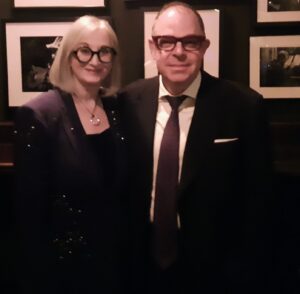
ARTISTS: Bill Charlap & Renee Rosnes
VENUE: Birdland, New York City
DATE: February 8, 2024
PERSONNEL: Bill Charlap, Renee Rosnes (p).
Pianists Bill Charlap and Renee Rosnes make beautiful music together. They have been a romantic couple for around two decades, and have been married for the past 17 years. Renee told me that one of the rooms in their house has two grand pianos, so whenever they are at home, the couple can play duets. In 2003, they recorded a splendid album of duos for Blue Note, “Double Portrait“, and a few years later, they accompanied Tony Bennett on his Jerome Kern tribute, “The Silver Lining“. However, their recent week-long engagement at Birdland revealed that in the years since those recordings, their duo style has evolved into something very special.
To my ears, Charlap and Rosnes are building upon the purest definition of jazz: transforming a piece of music into a vehicle for personal expression through the combination of unique arrangements and improvisation. While both pianists have great reverence for the composers of standards and jazz originals, their duo performances downplay the originals to emphasize the characteristics of their settings and solos. Over the course of two Birdland sets, they played 25 different songs, primarily standards, with some jazz classics and original compositions added in. What surprised me was a sudden realization that it really didn’t matter what song they were playing because my focus was consistently drawn to what Charlap and Rosnes added to the music. I could have chosen any of their tunes for discussion, as both sets were filled with equally great moments, but let me discuss their version of “My Funny Valentine”. Based on a head arrangement where few details were decided beforehand, the song started with a fairly straight-forward exposition of the melody. When the tempo increased to a medium walk and the solos began, the harmony receded to the distant background with the chords accented with a rhythmic obbligato. The rhythmic idea was an essential part of the arrangement as it emphasized the original idea over the standard harmonies. Over the top of this base were improvisations which were quite short, but always involved some degree of interplay between the two pianists. In the midst of the solos, I heard Charlap play a scalar passage, and then I saw Rosnes respond with a brilliant two-hand run up and down the keyboard. There was no sense of competition here; it was simply an example of the two pianists enhancing each other’s ideas. The final result was a stunning performance where the result was far more profound than the combination of its parts.
After hearing two incredible sets of piano duets by these two masters, I am convinced that they should start a podcast. While they had everything they needed at Birdland—two grand pianos, a rich and varied repertoire, light unscripted spoken introductions, and a very appreciative audience—they might be able to record the podcast from their home. With Marian McPartland‘s radio show “Piano Jazz” only existing in repeat broadcasts, I’m sure that many of their fans would be happy to subscribe to a series of non-competitive piano duets and conversations. And what wonderful music could Bill and Renee find as they explore this portion of their vast musical world?
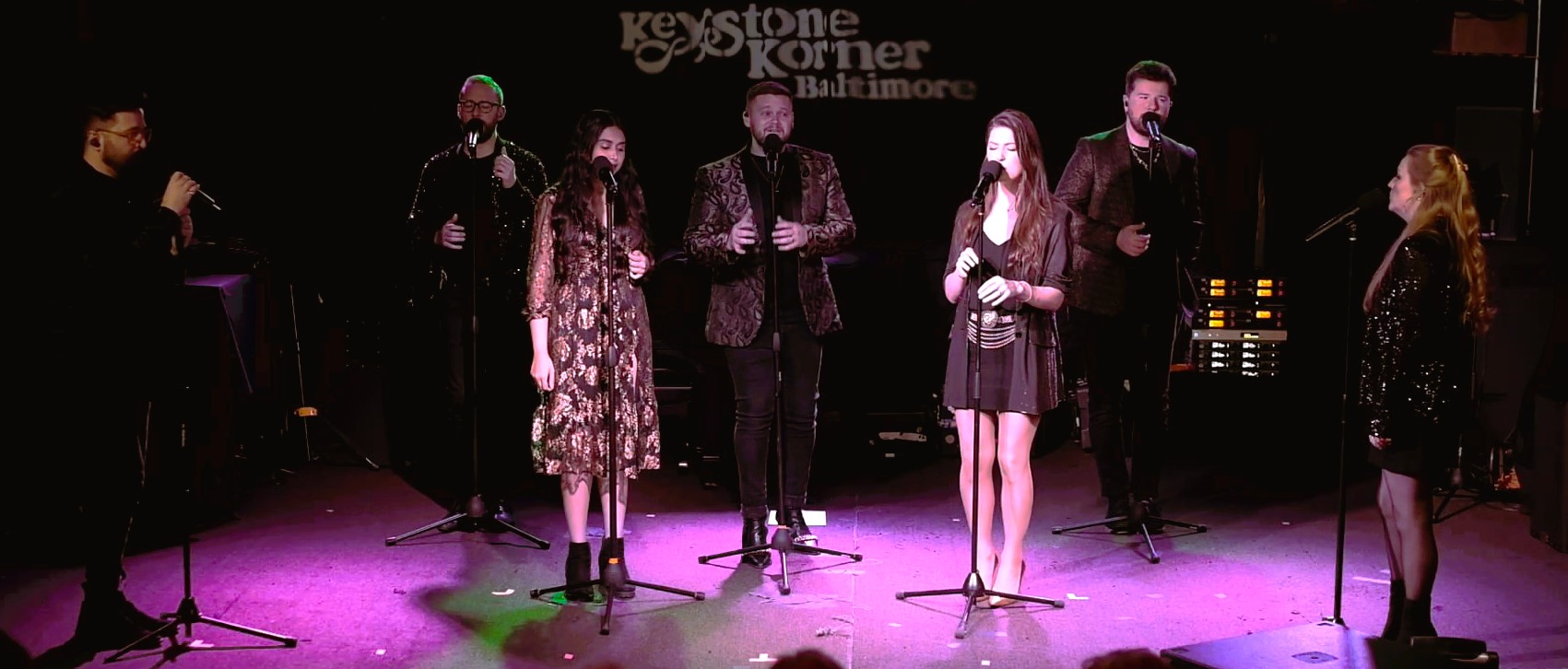
ARTISTS: The Swingles
VENUE: Keystone Korner, Baltimore, MD
DATE: February 1, 2024
PERSONNEL: Joanna Goldsmith-Eteson, Mallika Bhagwait, Midge Parry, Oliver Griffiths, Jon Smith, Jamie Wright, Tom Hartley (v).
A few weeks ago, I received a Facebook notification about The Swingles‘ upcoming US tour. It was announced as a fan request concert, so I dutifully responded with the suggestion “BACH” and made plans to catch the group in Baltimore at the Keystone Korner. The nightclub was an unusual setting for the group—compared to the concert halls where the group usually performs, the stage was cramped and the stage lighting less sophisticated. But as tenor Oliver Griffiths noted, it was a nice change to sing in a venue where he could also buy a beer. The group’s first two pieces kept with the expected repertoire of Swingle favorites, a British pop hit “Weather to Fly” and the Bulgarian folksong, “Bučimiš”, both performed with The Swingles’ usual mix of great precision and unerring intonation. Tenor Jon Smith‘s next stage announcement set the course for the concert. While “Bučimiš” was from the first Swingles CD he sang on, many of the pieces to follow were from a forthcoming album, “Theatreland”, which would be his final album with the group. In all, The Swingles premiered seven new arrangements from the project, with the rest of the album to be written before the group returns to the UK. The first premiere was “Hear My Song” by Jason Robert Brown, and the arrangement built from initial tender verses by sopranos Joanna Goldsmith-Eteson and Midge Parry, into a power ballad through solos by Griffiths and Smith. The coda held a special surprise with a sudden drop in dynamics and a stunning unison by Griffiths and Goldsmith-Eteson. It was so perfectly in tune that it wasn’t immediately apparent that there were two voices singing on the same note and in the same octave.
Before returning to the new arrangements, the group revisited a few more classics, including two settings from former member Edward Randell: a beautiful medley coupling the Keith Jarrett solo (lyricized by Kurt Elling) “Leaving” with the Sinatra classic, “In the Wee Small Hours”, and a swinging gender-switched feature for Smith on “Hallelujah, I Love Him So”. The latter chart has undergone a subtle rhythm transformation into an intimate soft-shoe, which is much more appropriate to its placement midway through the concert. After Goldsmith-Eteson’s spoken introduction to the live digital looping, the group featured its new soprano, Mallika Bhagwat on an emotional ballad, “Tokyo Sunrise”. While the song was a feature of her predecessor, Federica Basile, Bhagwat made the piece her own, and judging from her abundant talent, there should be new features for her in the near future (there’s already one set for the new album, which was the group’s encore at the Keystone). The looper, operated by master engineer Jack Golding, got a true workout on Goldsmith-Eteson’s “Narnia” which uses 43 separate looped segments, all recorded live within the 4-minute duration of the arrangement.
The focus returned to the theatre music with the Swingle ladies featured on Sara Bareilles‘ ethereal “Soft Place to Land”, followed by the atmospheric “Song of Purple Summer” from the rock musical “Spring Awakening”. Griffiths and Parry bought the roles of Orpheus and Eurydice into the present day with the “Wedding Song” from “Hadestown”, and in an interesting bit of programming, the tune was paired with a Swingle classic, “Lover’s Desire”. The arrangement of “Sunday” from Stephen Sondheim‘s “Sunday in the Park with George” is a pristine gem, and I suspect that many college jazz choirs will perform this setting whenever it is published. Smith left a parting gift with his show-stopping arrangement of “Sit Down, You’re Rockin’ the Boat”. All of these pieces promise to make “Theatreland” one of the great Swingle albums.
And what about my request for Bach? Yes, they did it, with two great Ward Swingle arrangements, the “Little Organ Fugue in G minor” and “Badinerie” with Goldsmith-Eteson’s brilliant vocal performance of the original flute part. During the post-concert celebration, I spoke several audience members who remembered the original French group from the 1960s. They loved the new music, but also wanted to hear a little more Bach. I must agree, as Bach has been absent from the last few Swingle concerts I have seen. If “Theatreland” has anywhere near the impact that I expect, the group could add many more fans. What a great opportunity to share J.S. Bach alongside Frank Loesser, Stephen Sondheim and Sara Bareilles!
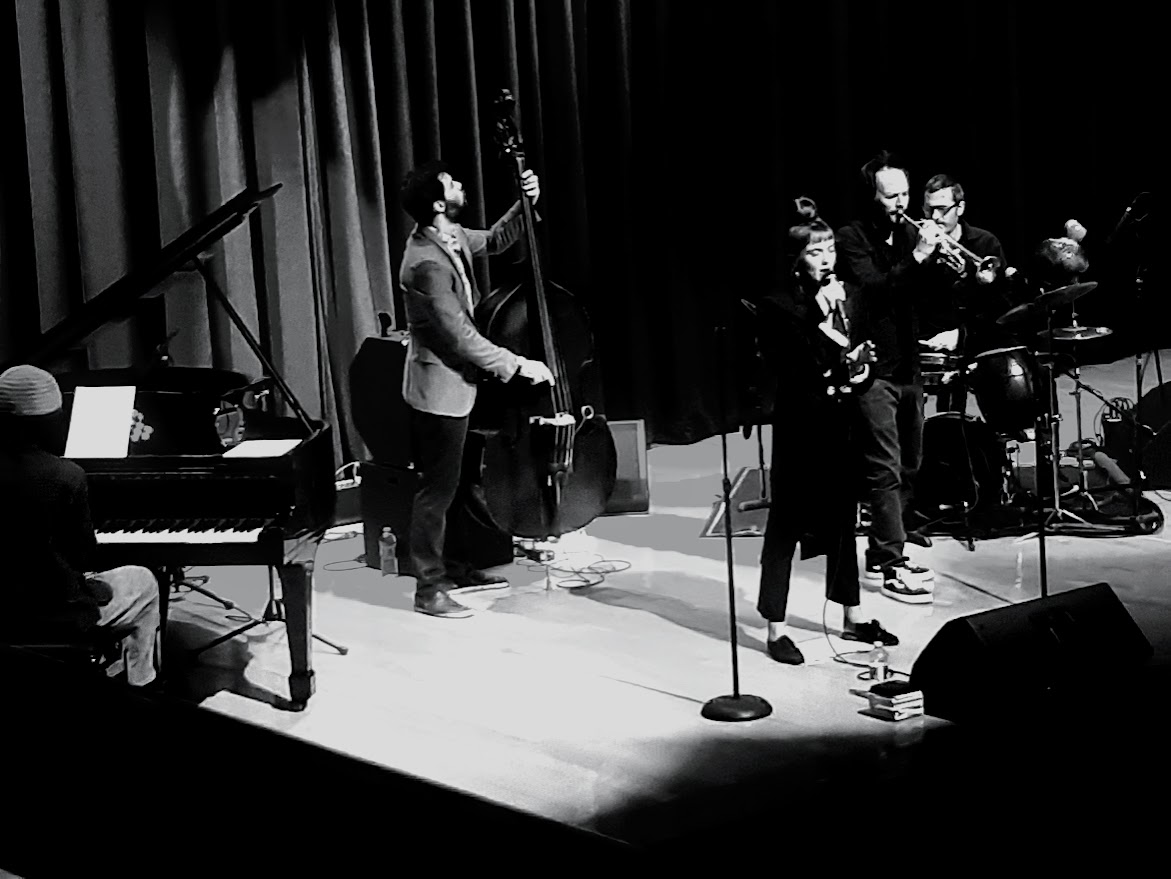
ARTIST: Camille Bertault
VENUE: Lycée Français Cultural Center, New York City
DATE: January 18, 2024
PERSONNEL: Camille Bertault (v); Julien Alour (tp); Cameron Campbell (p); Eduardo Belo (b); Franco Pina (d).
When I first saw a video of Camille Bertault, “The Girl on the Internet“, she sat stationary in her apartment, scatting John Coltrane solos note-for-note while the original records played on her stereo. Those clips were made when she was still a student, but they provided her with more than enough recognition to launch her solo career. The videos have continued, notably in a set of duets with Brazilian musicians which showed her physical involvement in the music. Recently, I saw her live in New York City, and it was a revelation to hear her sing—and watch her move—in a concert setting. The venue was a French school on the Upper East Side, and Bertault performed extended versions of the songs from her latest CD, “Bonjour Mon Amour” with a quartet of international musicians presently working in New York. All of the songs were sung in French, but Bertault took pity on the non-Francophiles in the audience and made all of her stage announcements in English. Bertault was hypnotic from the beginning. Wearing loose clothing and shoes which contrasted the looks of patent leather in front and beach sandals in the back, she danced whenever she was not singing, seductively moving her arms and legs while focusing on her subjects with her round intense eyes. Her scat solos were daring and concise, and at times, the tunes ended on an improvisation rather than circling back to the melody. Pianist Cameron Campbell is still in college, but he played brilliantly as both accompanist and soloist. Eduardo Belo displayed a rich tone and great flexibility, and Franco Pinna created unique sounds all night, playing on an unusual drum set with twin shallow snares, and tom-toms that resembled hollowed-out congas. Julien Alour—the only member of the quartet who also played on the CD—was a great front-line partner for Bertault, with superb improvisations that complimented and contrasted her solos. Alour also brought in three of his own Blue Note-styled originals, which were well-matched to Bertault’s compositions. The end of the concert was particularly charming: At about 90 minutes in, Bertault confessed that she had lost track of the time. There were two numbers left on the program, and she decided to let the audience choose one as the encore. The band played samples of both tunes, and the audience voted. However, with the crowd evenly split between the songs, Bertault sang both.
Bertault’s original compositions held several challenges for the instrumentalists. While the CD version of “Bonjour Mon Amour” runs under 35 minutes, it still reveals the complete compositions that were performed in New York. “Acrécran” has an uneven form of 30 bars, split in segments of 10 + 6 + 4 + 10 with abrupt changes of mood at several spots. “Un Grain de Sable” is even trickier, with a recurring 3-bar motive and various phrase lengths. Despite its title, “Bizarre” is a little more traditional with a 32-bar AABB form, but Bertault’s enigmatic vocal starts on the third beat of the first bar in each A section. No one, including me, believes that Bertault (or anyone else) should hew to the old song forms, and all of the musicians on the recording and at the concert had mastered Bertault’s formal variations so that they sounded natural in concert. For those who wish to hear Bertault in a more traditional setting, there is a new release on Sunnyside, “Songs for My Daughter” which features voice/piano duets by Bertault and her father Paul. The playlist includes several standards, some with new French lyrics by Camille. Her approach is very relaxed, singing way behind the beat and taking chances with the well-known melodies. Her scat is quite similar in texture and style to her live and recorded solos on the “Bonjour Mon Amour” songs, except for the additional flexibility allowed in the duo format. Paul is an extremely sensitive accompanist, and his understated touch is quite effective in his ballad solos. By far, the best track on the album is Billy Strayhorn‘s “Chelsea Bridge” with Camille caressing the classic melody with her lyrics and an airy vocal tone, over her father’s understated chords.